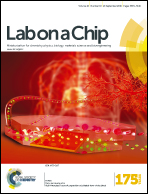Development and characterization of muscle-based actuators for self-stabilizing swimming biorobots†
Abstract
Biorobots that harness the power generated by living muscle cells have recently gained interest as an alternative to traditional mechanical robots. However, robust and reliable operation of these biorobots still remains a challenge. Toward this end, we developed a self-stabilizing swimming biorobot that can maintain its submersion depth, pitch, and roll without external intervention. The biorobot developed in this study utilized a fin-based propulsion mechanism. It consisted of a base made from two composite PDMS materials and a thin PDMS cantilever seeded with a confluent layer of heart muscle cells. The characterization of the heart muscle cell sheet revealed the gradual increase of the dynamic contraction force and the static cell traction force, which was accompanied by a linear increase in the expression levels of contractile and cytoskeletal proteins. In the design of the biorobot, instead of relying only on the geometry, we used two composite PDMS materials whose densities were modulated by adding either microballoons or nickel powder. The use of two materials with different mass densities enabled precise control of the weight distribution to ensure a positive restoration force on the biorobot tilted at any angle. The developed biorobot exhibited unique propulsion modes depending on the resting angle of its “fin” or the cantilever, and achieved a maximum velocity of 142 μm s−1. The technique described in this study to stabilize and propel the biorobot can pave the way for novel developments in biorobotics.


 Please wait while we load your content...
Please wait while we load your content...